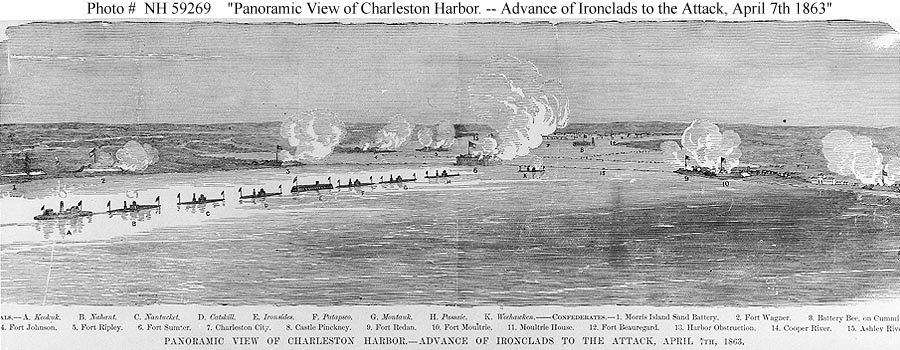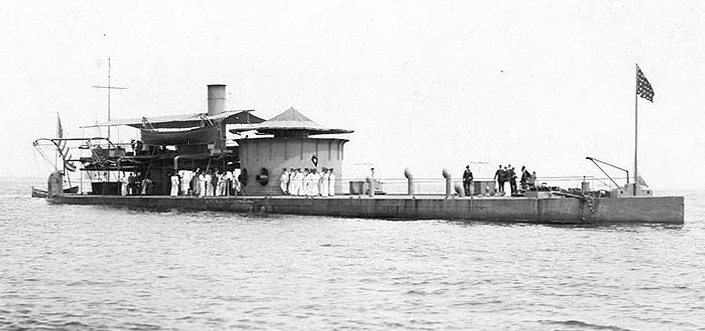|
USS Keokuk (1862)
USS ''Keokuk'' was an experimental ironclad screw steamer of the United States Navy named for the city of Keokuk, Iowa. She was laid down in New York City by designer Charles W. Whitney at J.S. Underhill Shipbuilders, at the head of 11th Street. She was originally named ''Moodna'' (sometimes incorrectly spelled "''Woodna''"), but was renamed while under construction, ship naming and launching, launched in December 1862 sponsored by Mrs. C. W. Whitney, wife of the builder, and ship commissioning, commissioned in early March 1863 with Commander Alexander Rhind, Alexander C. Rhind in command. Design ''Keokuk'' was one of the first warships to be of completely iron construction, with wood used only for deck planks and filler in the armor cladding. Her hull construction consisted of five iron box keelsons and one hundred 1-inch-thick (some sources report the thickness as 3/4 inch) by 4-inch-deep iron frames spaced 18 inches between centers. The frames included integral iron cross bea ... [...More Info...] [...Related Items...] OR: [Wikipedia] [Google] [Baidu] |
USS Weehawken (1862)
The first USS ''Weehawken'' was a ironclad monitor in the United States Navy during the American Civil War. She was named after Weehawken, New Jersey. History ''Weehawken'' was launched on 5 November 1862 at Jersey City, New Jersey by Zeno Secor & Company; sponsored by Ms. Nellie Cornstock; and commissioned on 18 January 1863, Captain John Rodgers in command. ''Weehawken'' was an improved and enlarged version of . Accompanied by and towed by , she departed New York on 18 January 1863, bound for Port Royal, South Carolina, and duty with the South Atlantic Blockading Squadron. The three vessels encountered gale-force winds and high seas off the New Jersey coast on 20 January. ''Iroquois'' and ''Boardman'' headed for sheltered waters; but Rodgers pressed on in ''Weehawken''. The ''Passaic'' ironclads differed from the original ''Monitor'' in having less deck overhang and a rounded lower hull. This enabled ''Weehawken'' – unlike her famous prototype – to ride out a hea ... [...More Info...] [...Related Items...] OR: [Wikipedia] [Google] [Baidu] |
Gun Battery, Fort Sumter (13147754703)
A gun is a ranged weapon designed to use a shooting tube (gun barrel) to launch projectiles. The projectiles are typically solid, but can also be pressurized liquid (e.g. in water guns/cannons, spray guns for painting or pressure washing, projected water disruptors, and technically also flamethrowers), gas (e.g. light-gas gun) or even charged particles (e.g. plasma gun). Solid projectiles may be free-flying (as with bullets and artillery shells) or tethered (as with Taser guns, spearguns and harpoon guns). A large-caliber gun is also called a ''cannon''. The means of projectile propulsion vary according to designs, but are traditionally effected pneumatically by a high gas pressure contained within the barrel tube, produced either through the rapid exothermic combustion of propellants (as with firearms), or by mechanical compression (as with air guns). The high-pressure gas is introduced behind the projectile, pushing and accelerating it down the length of the tube, ... [...More Info...] [...Related Items...] OR: [Wikipedia] [Google] [Baidu] |
Fort Sumter
Fort Sumter is a sea fort built on an artificial island protecting Charleston, South Carolina from naval invasion. Its origin dates to the War of 1812 when the British invaded Washington by sea. It was still incomplete in 1861 when the Battle of Fort Sumter began the American Civil War. It was severely damaged during the war, left in ruins, and although there was some rebuilding, the fort as conceived was never completed. Since the middle of the 20th century, Fort Sumter has been open to the public as part of the Fort Sumter and Fort Moultrie National Historical Park, operated by the National Park Service. The building of Fort Sumter Named after General Thomas Sumter, a Revolutionary War hero, Fort Sumter was built after the 1814 Burning of Washington during the War of 1812 as one of the third system of U.S. fortifications, to protect American harbors from foreign invaders such as Britain. Built on an artificial island in the middle of the channel that provides Charlesto ... [...More Info...] [...Related Items...] OR: [Wikipedia] [Google] [Baidu] |
Fort Moultrie
Fort Moultrie is a series of fortifications on Sullivan's Island, South Carolina, built to protect the city of Charleston, South Carolina. The first fort, formerly named Fort Sullivan, built of palmetto logs, inspired the flag and nickname of South Carolina, as "The Palmetto State". The fort was renamed for the U.S. patriot commander in the Battle of Sullivan's Island, General William Moultrie. During British occupation, in 1780–1782, the fort was known as Fort Arbuthnot. History American Revolution Col. Moultrie took command of Sullivan's Island on March 2, 1776, which included a garrison of 413 men of the 2nd South Carolina Regiment of Infantry and 22 men of the 4th South Carolina Regiment, artillery. The island included a fort, still under construction at the southern tip, which was being supervised by Capt. De Brahm. The square design, with corner bastions, was supposed to have parallel rows of palmetto logs , filled in with . However, by June 28, only th ... [...More Info...] [...Related Items...] OR: [Wikipedia] [Google] [Baidu] |
Naval Mine
A naval mine is a self-contained explosive device placed in water to damage or destroy surface ships or submarines. Unlike depth charges, mines are deposited and left to wait until they are triggered by the approach of, or contact with, any vessel or a particular vessel type, akin to anti-infantry vs. anti-vehicle mines. Naval mines can be used offensively, to hamper enemy shipping movements or lock vessels into a harbour; or defensively, to protect friendly vessels and create "safe" zones. Mines allow the minelaying force commander to concentrate warships or defensive assets in mine-free areas giving the adversary three choices: undertake an expensive and time-consuming minesweeping effort, accept the casualties of challenging the minefield, or use the unmined waters where the greatest concentration of enemy firepower will be encountered. Although international law requires signatory nations to declare mined areas, precise locations remain secret; and non-complying individ ... [...More Info...] [...Related Items...] OR: [Wikipedia] [Google] [Baidu] |
First Battle Of Charleston Harbor
The First Battle of Charleston Harbor was an engagement near Charleston, South Carolina that took place April 7, 1863, during the American Civil War. The striking force was a fleet of nine ironclad warships of the Union Navy, including seven monitors that were improved versions of the original . A Union Army contingent associated with the attack took no active part in the battle. The ships, under command of Rear Admiral Samuel Francis Du Pont, attacked the Confederate defenses near the entrance to Charleston Harbor. Navy Department officials in Washington hoped for a stunning success that would validate a new form of warfare, with armored warships mounting heavy guns reducing traditional forts. Du Pont had been given seven of the Passaic class monitors, the powerful , and the experimental ironclad . Other naval operations were sidetracked as their resources were diverted to the attack on Charleston. After a long period of preparation, conditions of tide and visibility allowed ... [...More Info...] [...Related Items...] OR: [Wikipedia] [Google] [Baidu] |
Stono Bar
Stono, also known as Jordan's Point (pronounced "Jer-don"), is a historic home located at Lexington, Virginia. It was built about 1818, and is a cruciform shaped brick dwelling consisting of a two-story, three-bay, central section with one-story, two-bay, flanking wings. The front facade features a two-story Roman Doric order portico with a modillioned pediment and lunette and a gallery at second-floor level. About 1870, a -story rear wing was added connecting the main house to a formerly separate loom house. Also on the property are a contributing summer kitchen, ice house, and office. an''Accompanying photo''/ref> It was listed on the National Register of Historic Places in 1975. It is located in the Lexington Historic District. References External links Stono, Institute Hill, Lexington, Lexington, VA 13 photos, 8 measured drawings, 7 data pages, and 1 photo caption page at Historic American Buildings Survey Heritage Documentation Programs (HDP) is a division of the ... [...More Info...] [...Related Items...] OR: [Wikipedia] [Google] [Baidu] |
USS Nahant (1862)
The first USS ''Nahant'' was a ironclad monitor of the United States Navy that saw service in the American Civil War and the Spanish–American War. ''Nahant'' was launched on October 7, 1862, by Harrison Loring, South Boston, Massachusetts, and commissioned on December 29, 1862, Commander John Downes in command. Service history Fort McAllister The new single- turreted monitor joined the South Atlantic Blockading Squadron at Port Royal Harbor, South Carolina on February 20, 1863, and saw her first action in the Union bombardment of Fort McAllister on March 3. Charleston A little over a month later, she participated in Rear Admiral Samuel Francis du Pont's valiant but ill-fated attack on Charleston Harbor. The ironclads crossed Stono Bar and entered Charleston Harbor on 6 April, but a heavy fog stopped their advance lest they run aground attempting to negotiate the tricky channels leading to the vital Confederate port. Though dawn broke clear the next morning, an ebb tide k ... [...More Info...] [...Related Items...] OR: [Wikipedia] [Google] [Baidu] |
USS Nantucket (1862)
The first USS ''Nantucket'' was a coastal monitor in the United States Navy. ''Nantucket'' was launched 6 December 1862 by Atlantic Iron Works, Boston, Massachusetts; and commissioned 26 February 1863, Commander Donald McNeil Fairfax in command. Assigned to the South Atlantic Blockading Squadron, ''Nantucket'' participated in the attack on Confederate forts in Charleston Harbor 7 April 1863. Struck 51 times during the valiant but unsuccessful assault on the vital Southern port, the single-turreted monitor was repaired at Port Royal but returned to Charleston to support Army operations on Morris Island, engaging Fort Wagner 16, 17, 18, and 24 July. She captured British steamer ''Jupiter'' at sea 15 September. She again challenged the Charleston Harbor forts 14 May 1864 and thereafter remained on blockade duty through the end of the American Civil War. Decommissioned at Philadelphia Navy Yard 24 June 1865, she remained in ordinary there for a decade. Renamed ''Medusa'' 15 J ... [...More Info...] [...Related Items...] OR: [Wikipedia] [Google] [Baidu] |
USS Catskill (1862)
USS ''Catskill'' was a monitor built for the United States Navy during the American Civil War. She continued to serve the Navy after the war's end until decommissioned in 1898 after the end of the Spanish–American War. Service history Civil War USS ''Catskill''—a single-turreted monitor—was launched on December 16, 1862 by Continental Iron Works, Greenpoint, New York; outfitted at New York Navy Yard; commissioned on February 24, 1863, Commander George Washington Rodgers in command; and reported to the South Atlantic Blockading Squadron. ''Catskill'' reported for duty at Port Royal, South Carolina on March 5, 1863, and for the remainder of the war operated off Charleston, South Carolina. ''Catskill'' was damaged by Confederate gunfire during the 7 April attack on Fort Sumter that demonstrated both the strengths of well-defended fortifications and the limitations of monitor-type ironclads. That began the lengthy series of operations against the strongly fortified and ... [...More Info...] [...Related Items...] OR: [Wikipedia] [Google] [Baidu] |







